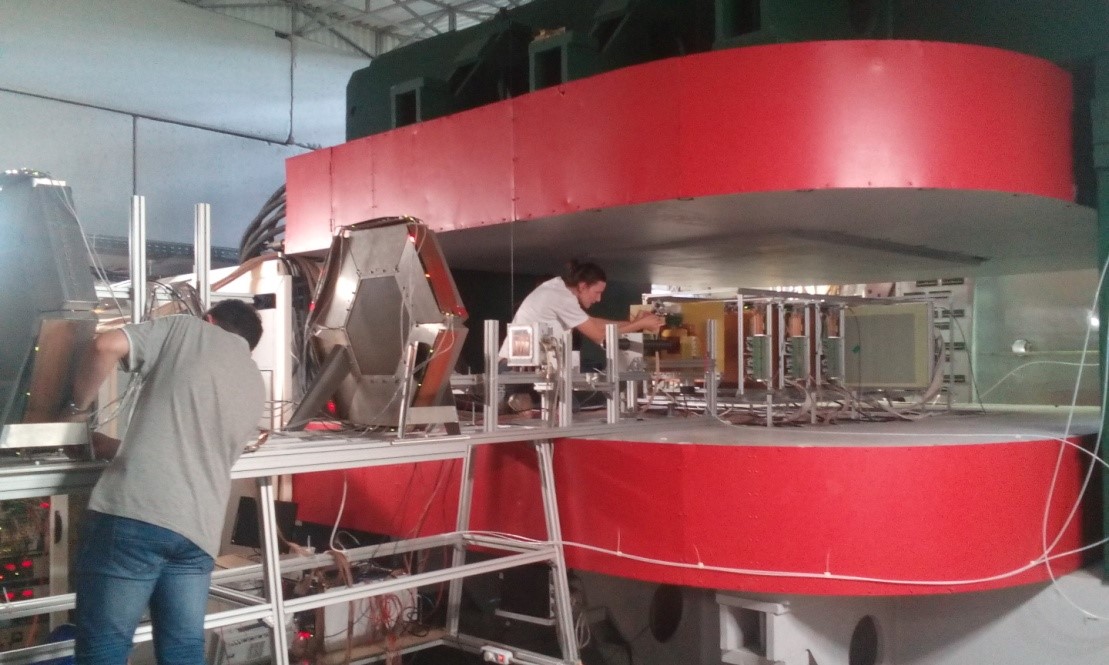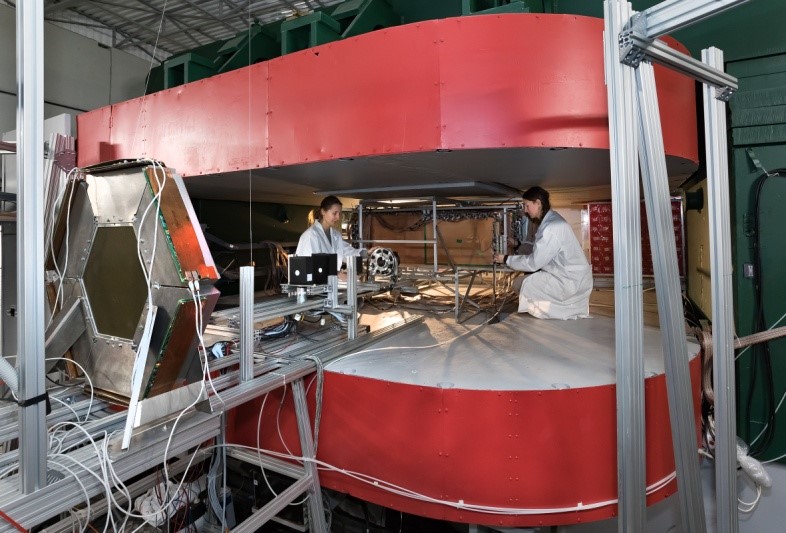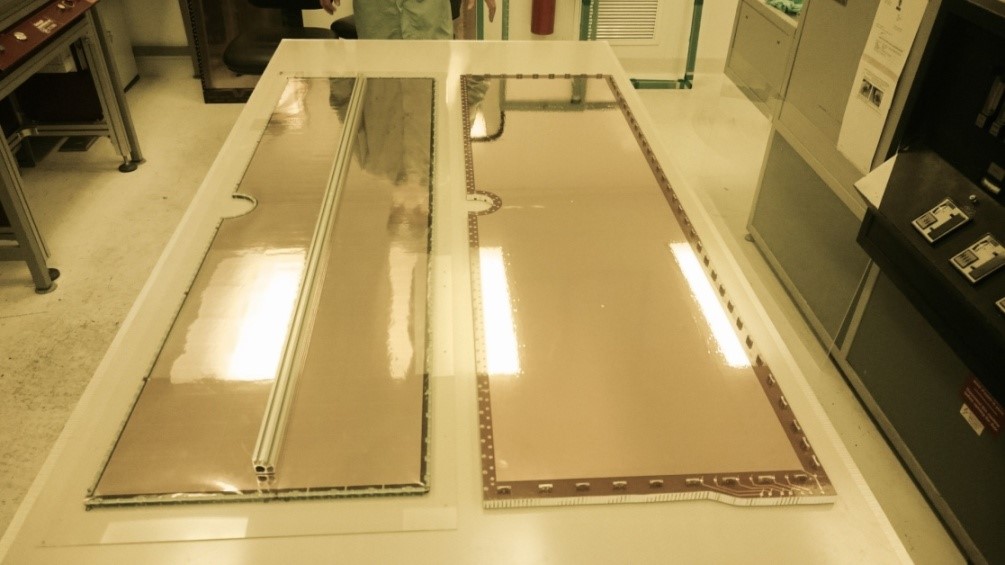First stage of the BM@N GEM central tracking system
Publications, 13 October 2020
The team of authors comprising of A. Galavanov, S. Habarov, E. Kulish, M. Kapishin, A. Makankin, A. Maksymchuk, S. Vasiliev was awarded for the scientific work “First stage of the BM@N GEM central tracking system” with the second JINR Prize for 2019 in the section “Methodological and Technological Research Work”.
The study of the properties of nuclear matter under extreme conditions is one of the most rapidly developing areas of modern physics. Relativistic heavy ion collisions provide the unique opportunity to investigate the properties of nuclear matter at ultra-high density and temperature. Heavy ion experiments are intensively carried out or planned in various world scientific centers. The first experiment at the accelerator complex of NICA-Nuclotron – BM@N (Baryonic Matter at Nuclotron) – is aimed to study nuclear-nuclear (up to “gold-gold”) collisions at high densities. The main goal of the experiment is to study the interactions of relativistic heavy ion beams with fixed targets. Experimental interest is focused on the hadrons with strangeness, which are produced in collisions and do not exist in the initial state of two colliding nuclei. The measurements will be carried out at the BM@N experimental setup, located at the extracted beam of the Nuclotron. The Nuclotron heavy ion beam energy range corresponds to √sNN=2.3÷3.5 GeV. It is well suited for studies of strange mesons and multi-strange hyperons which are produced in nucleus-nucleus collisions close to the kinematic threshold. The maximum in the hyper-nuclei production rate predicted by the thermal model is also close to the Nuclotron energy range.
 Images 1-2. GEM detectors integration into the BM@N experimental setup
Images 1-2. GEM detectors integration into the BM@N experimental setup
The BM@N experiment combines high precision track measurements with time-of-flight information for particle identification. The magnetic field of the analyzing magnet can be varied up to 1 T to get the optimal detector acceptance and momentum resolution for different reactions and beam energies. The first physical data were recorded by the experimental setup in 2017 with the carbon beam. After the heavy ion source “Kryon” was launched, relativistic argon and krypton beams were accelerated and transported to the BM@N setup in February–March 2018 for the first time. During the run, about 130 million events were recorded. The analysis of the experimental data will provide information about the products of interaction of “medium” ion beams with various targets (carbon, aluminium, copper, tin, lead).
A wide-aperture central tracking system of the BM@N experimental setup is located downstream the target inside the analyzing magnet. The momentum of charged particles — the products of interactions of the beam with the target — is measured by the curvature of their trajectories in a magnetic field. The high intensity of interactions and a large multiplicity of charged particles in each event cause increased requirements for detectors: high spatial and time resolution, the capability to operate at loads of up to 106 ions per second, and the possibility of stable operation in strong magnetic fields. For this reason for the first time at JINR multilayer GEM (Gas Electron Multipliers) detectors were chosen for the central part of the tracking system. In order to achieve the maximum possible acceptance within the aperture of the analyzing magnet of the BM@N setup a team of authors developed and assembled GEM detectors with an active area of 1630×450 mm2, which are currently the largest GEM detectors in the world.
Each detector consists of a cathode plane, three gas electron multipliers (GEM foils) and an anode readout plane. One GEM foil is made of a 50 µm kapton foil clad on both sides with 5 µm copper electrodes. The GEM foil is optically semi-transparent due to chemical perforation by a large number of holes of about 70 µm diameter, separated by a distance of 140 µm.
For the BM@N experiment were selected three foil (three-layer GEM detectors) detectors with the following gas gap geometry: 3 mm drift gap, 2.5 mm first transfer gap, 2 mm second transfer gap and 1.5 mm induction gap. Such a design makes it possible to achieve stable operation with a gas gain of up to 105.
Work on the development of the central tracking system of the BM@N experiment was started in 2014. Over the years a team of authors has done a large amount of work on simulation, development, assembly, study of GEM detectors and readout electronics characteristics. The total active area of the first stage of the tracking system is 5 m2; and 45000 channels of readout electronics are needed for data acquisition.
The first stage of the central tracking system was successfully integrated into the BM@N experimental setup and tested during runs with extracted beams of deuterium, carbon, argon, and krypton ions. The operation of the tracking system made it possible to reconstruct the hyperons decay products produced in interactions of Nuclotron beams with fixed targets.
Publications:
- D. Baranov, S. Bazylev, M. Kapishin, K. Kapusniak, V. Karjavine, S. Khabarov, A. Kolesnikov, E. Kulish, V. Lenivenko, A. Makankin, A. Maksymchuk, B. Mehl, R. De Oliveira, V. Palchik, A. Rodriguez, I. Rufanov, A. Shutov, I. Slepnev, V. Slepnev and S. Vasiliev, «GEM tracking system of the BM@N experiment». International Conference on Instrumentation for Colliding Beam Physics (INSTR17) proceeding. Journal of Instrumentation, Volume 12, ISSN:1748-0221, June 2017.
- S. Bazylev, M. Kapishin, K. Kapusniak, V. Karjavine, S. Khabarov, A. Kolesnikov, E. Kulish, V. Lenivenko, A. Makankin, A. Maksymchuk, B. Mehl, R. De Oliveira, V. Palchik, G. Pokatashkin, A. Rodriguez, I. Rufanov, A. Shutov, I. Slepnev, V. Slepnev, S. Vasiliev and A. Zinchenko, «Triple GEM tracking detectors for the BM@N experiment». The 3rd International Conference on Particle Physics and Astrophysics (ICCPA 2017) proceeding. Knowledge E, KnE Energy & Physics, ISSN: 2413-5453, p. 268-274.
- S. Bazylev, M. Kapishin, K. Kapusniak, V. Karjavine, S. Khabarov, A. Kolesnikov, E. Kulish, V. Lenivenko, A. Makankin, A. Maksymchuk, B. Mehl, R. De Oliveira, V. Palchik, G. Pokatashkin, A. Rodriguez, I. Rufanov, A. Shutov, I. Slepnev, V. Slepnev, S. Vasiliev and A. Zinchenko, «Study of the GEM detector performance in BM@N experiment». The XXI International Scientific Conference of Young Scientists and Specialists (AYSS-2017) proceeding. EPJ Web Conf., 177 (2018) 04004.
- M. Kapishin, V. Karjavine, E. Kulish, V. Lenivenko, A. Makankin, A. Maksymchuk, V. Palchik and S. Vasiliev, «GEM Detector Performance Assessment in the BM@N». International Conference «Mathematical Modeling and Computational Physics» (MMCP 2017) proceeding. EPJ Web of Conferences, 173(2018), 04007.
- Sergey Khabarov, Elena Kulish, Vasilisa Lenivenko, Alexander Makankin, Anna Maksymchuk, Vladimir Palichik, Maria Patsyuk, Sergey Vasiliev, Aleksander Vishnevskij, Nikolay Voytishin, «First glance at the tracking detectors data collected in the first BM@N SRC run». The XXII International Scientific Conference of Young Scientists and Specialists (AYSS-2018) proceeding. EPJ Web of Conferences 201, 04002 (2019).
- D. Baranov, M. Kapishin, E. Kulish, A. Maksymchuk, T. Mamontova, G. Pokatashkin, I. Rufanov, V. Vasendina, and A. Zinchenko, «First results from BM@N technical run with deuteron beam». Physics of Particles and Nuclei Letters, ISSN:1547-4771, eISSN:1531-8567, p. 148-156.
- A. Galavanov, M. Kapishin, K. Kapusniak, V. Karjavine, S. Khabarov, Y. Kirushin, A. Kolesnikov, E. Kulish, V. Lenivenko, A. Makankin, A. Maksymchuk, B. Mehl, R. De Oliveira, V. Plotnikov, G. Pokatashkin, A. Rodriguez, M. Rumyantcev, I. Rufanov, V. Sidorenko, S. Vasiliev, and A. Vishnevskiy, «GEM/CSC tracking system of the BM@N experiment at the Nuclotron». XXIVth International Baldin Seminar on High Energy Physics Problems proceeding. EPJ Web of Conferences, 204 (2019) 07009.
- A. Galavanov, M. Kapishin, V. Karjavine, S. Khabarov, Y. Kirushin, E. Kulish, N. Kuzmin, V. Lenivenko, A. Makankin, A. Maksymchuk, S. Piyadin, V. Plotnikov, G. Pokatashkin, M. Rumyantcev, I. Rufanov, V. Sidorenko, A. Vishnevskiy, and S. Vasiliev, «Study of the BM@N GEM/CSC Tracking System Performance», The XXIII International Scientific Conference of Young Scientists and Specialists (AYSS-2019) proceeding. AIP Publishing to be published.
- A. Galavanov, M. Kapishin, V. Karjavine, S. Khabarov, E. Kulish, V. Lenivenko, A. Makankin, A. Maksymchuk, G. Pokatashkin, I. Rufanov, S. Vasiliev, «Large area BM@N GEM detectors». The 6th International Conference on Micro Pattern Gaseous Detectors (MPGD19) proceeding. Journal of Physics: Conference Series (JPCS), to be published.
- Васильев С.Е., Галаванов А.В., Капишин М.Н., Каржавин В.Ю., Кулиш Е.М., Ленивенко В.В., Маканькин А.М., Максимчук А.И., Пиядин С.М. и Хабаров С.В., «Исследование характеристик GEM детекторов эксперимента BM@N», Письма в ЭЧАЯ, т.16, №6 (2019) ISSN:1814-5957, eISSN:1814-5973, Изд:ОИЯИ
Anna Maksymchuk, Senior Scientific Reseacher at VBLHEP

